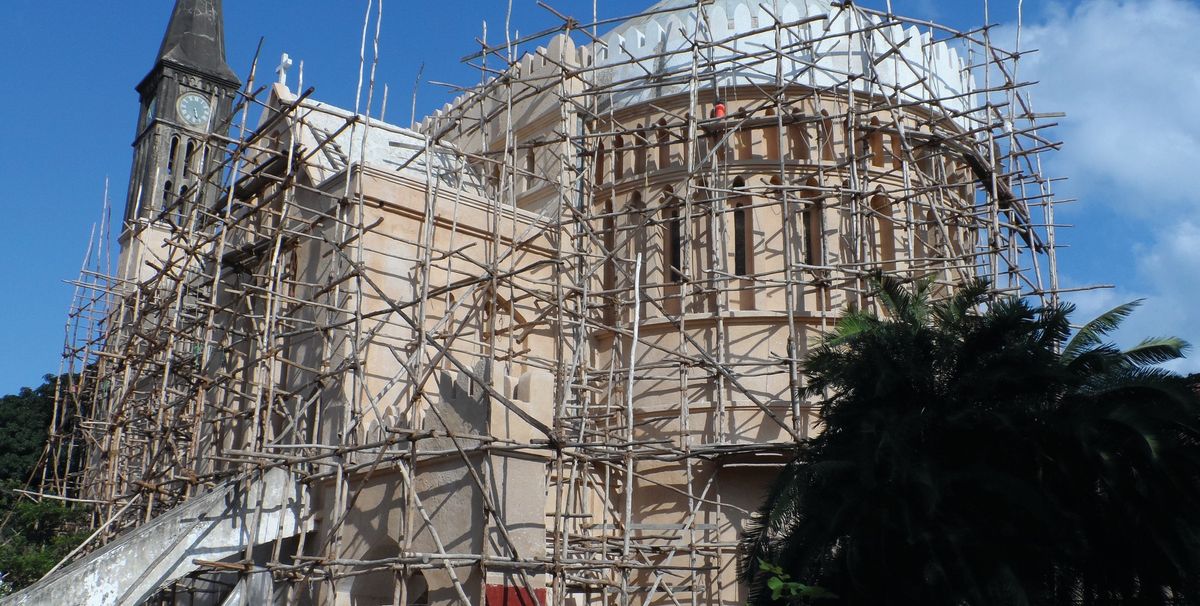It’s a tough time for heritage. On 11 and 12 December Isil recaptured the ancient city of Palmyra in Syria, taking advantage of Syrian and Russian concentration on Aleppo, another ancient, and now ruined, city. Eighteen months ago a plume of smoke rising above the Temple of Bel in Palmyra marked the destruction of 2,000 years of history and reminded us of the senseless intolerance of some religious fanaticism.
But, search harder and there are positive, uplifting stories relating to heritage sites, some born from the darkest of histories. The Anglican Christ Church Cathedral in Zanzibar is a special place. Not only is it an extraordinary architectural melange of European Gothic, Arabic and Swahili styles, but it also marks the site of the last and biggest permanent slave market in East Africa. When the market was closed by the ruler of Zanzibar, Sultan Barghash, in 1873 the cathedral was constructed as a triumph of hope over human suffering, the altar deliberately placed over the site of the former whipping post.
In a predominantly Muslim country the architects took great care to follow local traditions and ensured that the clock tower was not as high as the sultan’s palace. The first service in the cathedral was held 140 years ago, on Christmas Day 1877.
Building at risk Four years ago the cathedral was in a parlous state, despite its importance and its place at the heart of the original trading settlement of Stone Town, a Unesco World Heritage Site. The exterior was crumbling and the towering walls of the nave were in danger of pulling themselves apart.
The local Anglican diocese highlighted the issue in 2012 and the cathedral was placed on the World Monuments Watch list in 2014. Working with partners and supported both locally and by the European Union, the US Embassy in Dar es Salaam and the US Ambassadors Fund for Cultural Preservation, a restoration plan was hatched.
Over the past two years an extensive scheme has been under way. The nave has been pinned together by 20 stainless steel ties, the roof completely replaced and the great rose window, the earliest in Sub-Saharan Africa, brought back to life.
An unexpected discovery during conservation was that the Arabic crenellations on the top of the apse were originally made from bright, white “neeru”, a type of lime-based plaster. This technique uses a mixture of crushed marble dust that is thinly applied and then highly polished using metal trowels. The result is a shining halo affect, one that is both deliberate and appropriate.
If the story ended there it would be interesting—but two things elevate it above a fascinating conservation initiative. While the restoration of the church’s historic fabric was important, it went hand in hand with an intensive programme of skills development. Consequently, there is now a pool of local trained stonemasons who will be available to help with future repairs, and who also have the specialist knowledge to restore the unique architectural heritage of the Stone Town and further afield.
Confronting slavery The cathedral was built, in part, so that slavery’s dark past would not be forgotten. Here, the trade in human lives transcended sectarian divides and affected everyone, and yet it is not a tale that is easily told. So, along with the restoration of the church, the project also led to the creation of a new education centre dedicated to presenting the story of slavery.
Yes, this is a conservation story but it is also about helping to maintain something that sits at the heart of the local economy—tourism is a critical industry in Zanzibar and the cathedral is one of the most visited of the town’s attractions.
Hearteningly, it is also about tolerance and co-operation. The vast majority of those who worked on the project were Muslim, from the trainee masons to the tour guides, from local government officials to the curators of the new exhibition centre. At a time when heritage has been in the news for all the wrong reasons, it is good to have an example of care for the past that unites, rather than divides.
• John Darlington is executive director of the World Monuments Fund Britain


